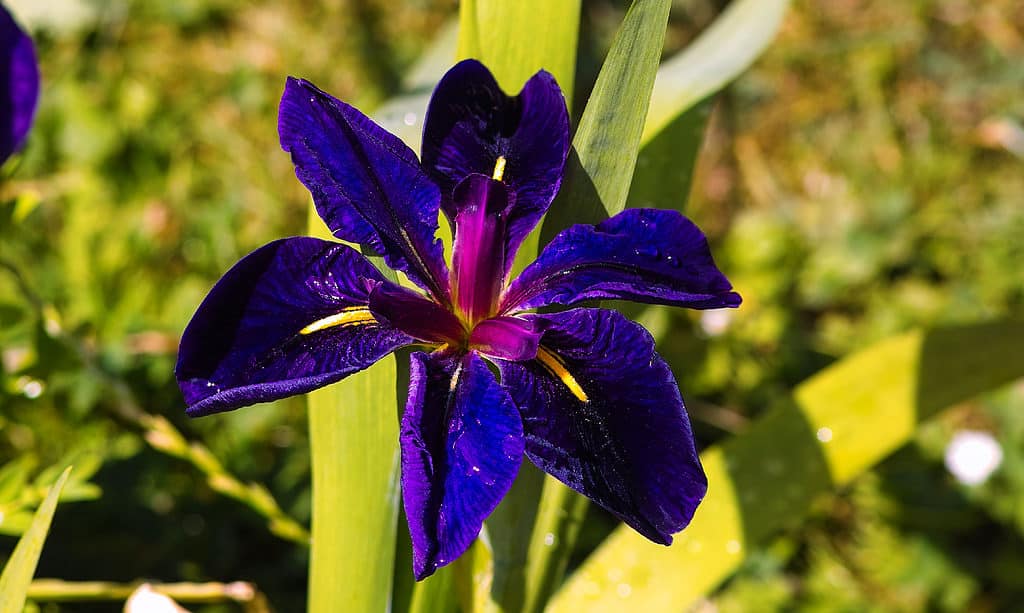Louisiana is home to a diverse number of native plants that naturally grow in the state, ranging from evergreens, cypress trees, flowers, and bushes. These plants can be seen around Louisiana and grown with less difficulty than other varieties, as they are native to Louisiana’s climate and overall environment.
Let’s explore 9 different native plants that can be found in Louisiana.
1. Louisiana Phlox (Phlox divaricata)
The Louisiana phlox is an herbaceous perennial wildflower that clumps together and reaches a height of 12 inches. You can find it throughout the forest floor in eastern North America, and the fragrant bloom is an attraction for insects such as bees and butterflies.
This plant has light purplish to magenta-colored flowers that bloom and grow best during the springtime. Louisiana phlox grows horizontally and spreads out to form a bushy plant with beautiful clusters of flowers.
The best time to grow Louisiana phlox is in spring, and the seeds or young plants should be spaced out so that they have space to grow and form a bushy appearance. This plant is fairly easy to care for and doesn’t require much watering or fertilizer, however, a good quality fertilizer can help the plant establish itself better.
2. Spicebush (Linderia benzoin)

Spicebush reaches a height of 6 to 12 feet.
©ForestSeasons/Shutterstock.com
The spicebush is a native plant in Louisiana that is important for wildlife. This is a type of tree-like shrub that produces both flowers and fruit, and the yellow flowers and deep green leaves are distinctive features. The flowers bloom in spring and help attract pollinating insects while being a food source for wildlife like deer.
Spicebush reaches a height of 6 to 12 feet and spreads horizontally and vertically. It can mix in with other native plants and trees to form coverage. The stem has small branches that grow the flowers and leaves on, and it is a dark brown color with a thick base.
During spring and late summer, the female spicebush produces small red berries that cluster on the plant.
3. Gulf Coast Yucca (Yucca louisianensis)

Gulf coast yucca blooms during mid-summer and spring.
©William L. Farr / CC BY-SA 4.0 – License
The gulf coast yucca (also known as the Louisiana yucca) is a small shrub plant that has long leaves with a central flower stalk. This plant grows to a height of 3 feet and produces greenish-white flowers in spring on a stalk that gives the plant an added height of up to 9 feet.
This type of yucca is commonly found in Louisiana’s dry and sand uplands and grows in partially sunny areas. Gulf coast yucca blooms during mid-summer and spring, and sometimes in the early fall once they are mature. Once the gulf coast yucca has bloomed at maturity, it will re-bloom every year.
4. Swamp Azalea (Rhododendron viscosum)

Swamp azalea produces white flowers that have an attractive fragrance for hummingbirds and bees.
©Scenic Corner/Shutterstock.com
The pretty blooming flower called the swamp azalea, or clammy azalea is a type of broadleaf evergreen with a shrub-like appearance. Swamp azalea grows to a height of 2 to 8 feet, with a width of 3 to 8 feet. This plant grows in partial shade and prefers a moist environment with well-draining soil, so the roots are not sitting in water.
During May to July, swamp azalea produces white flowers that have an attractive fragrance for hummingbirds and bees, and the flowers are small and cluster together between the small green leaves.
5. Bald Cypress (Taxodium distichum)

Bald cypress grows in both wet and dry conditions.
©Danita Delimont/Shutterstock.com
The bald cypress is one of the official state trees of Louisiana, along with being a symbol of the southern swamps. This deciduous conifer tree grows to around 70 feet tall and 25 feet wide, and some of the older bald cypresses can grow even larger to a height of 150 feet.
Bald cypress grows in both wet and dry conditions, only requiring a moderate amount of water. This tree grows enjoys humidity and flooded environments, even though they can tolerate a period of dry soil during the year.
Bald cypress has a pyramid shape, and the leaves are green and needle-like but will turn orange in fall before shedding the leaves.
6. Louisiana Iris (Iris ser. Hexagonae)

All five species of the Louisiana iris are found in south Louisiana.
©Ole Schoener/Shutterstock.com
The Louisiana iris consists of five different species of iris plants that are native to Louisiana. These five species include:
- Iris hexagona
- Iris giganticaurulea
- Iris nelsonii
- Iris fulva
- Iris brevicaulis
Each of the different species of Louisiana iris has its own habitat and phenotypes, but they are all closely related to one another. Louisiana iris plants have brightly colored flowers, ranging from red, purple, and even blue. The flowers are quite attractive and look great amongst the plant’s long and slender green leaves.
All five species of the Louisiana iris are found in south Louisiana, and their bloom is quite a sight to see.
Louisiana iris reaches a height of 2 to 3 feet, and the flower stems range from 3 to 7 inches in height. This flowering plant blooms in April after being dormant for the water, and the plant’s growth rate increases when the weather cools down in October, beginning to bloom beautiful flowers from March to April.
7. Cream Wild Indigo (Baptisia bracteata)

Cream wild indigo attracts insects and pollinators such as bees.
©Joshua Mayer / flickr – License
The cream wild indigo is a type of herbaceous perennial plant that can be found in dry soils in forests and savannahs. This plant only reaches a height of 2 feet with multiple stems branching out. The stems and leaves have fine hairs covering them giving them stem a purplish-grey appearance, with the leaves being a light greyish-green color.
Cream wild indigo grows whitish yellow (cream) flowers that grow between 1 to 2 inches long and have a puffy appearance. These flowers attract insects and pollinators such as bees. The cream wild indigo blooms in late spring, and the blooming period lasts for around 6 weeks.
8. Swamp Lily (Crinum americanum)

Swamp lilies bloom during the warmer months of the year.
©iStock.com/passion4nature
The swamp lily or swamp spider lily is a fascinating yet beautiful flowering plant that grows pure white flowers in a unique shape. Swamp lilies grow in groups and have long, slender dark green leaves with long stalks where the flowers bloom. This plant grows to around 3 to 5 feet tall, and 2 to 3 feet wide.
The most interesting part of this flowering lily is that its flowers have a spider-like shape, with a nice smelling fragrance that attracts pollinating insects. Swamp lilies bloom during the warmer months of the year, and the flowers have a white coloration with long petals on either side of the flower and a style that holds the anthers with pollen and stigma.
Up Next:
The photo featured at the top of this post is © Jeff Holcombe/Shutterstock.com
Thank you for reading! Have some feedback for us? Contact the AZ Animals editorial team.






